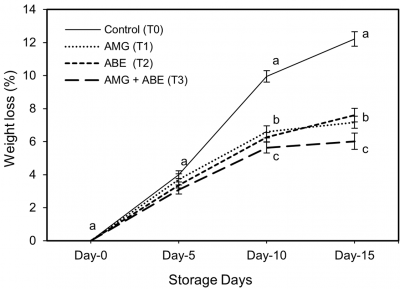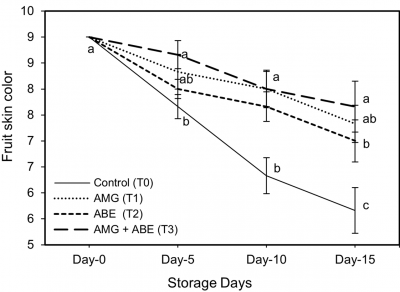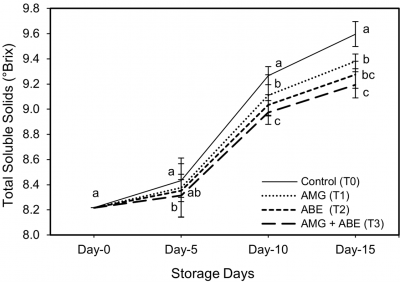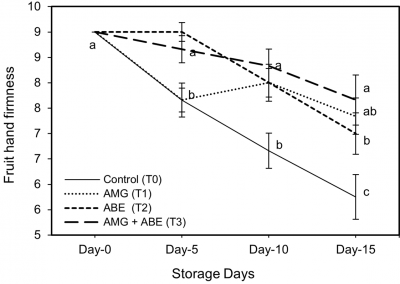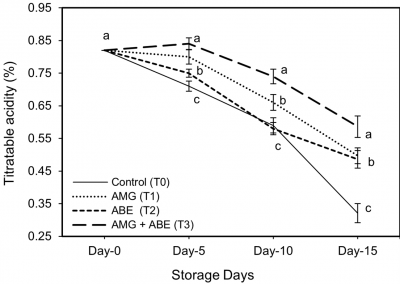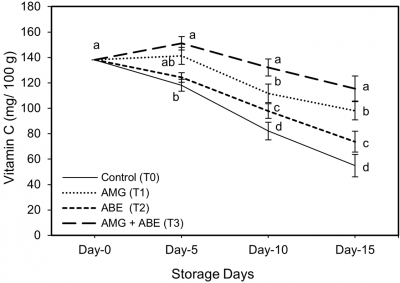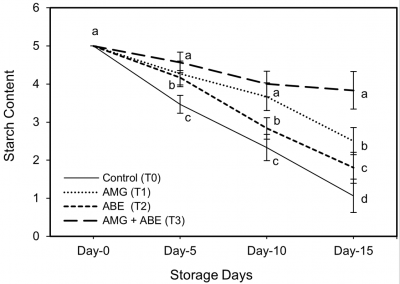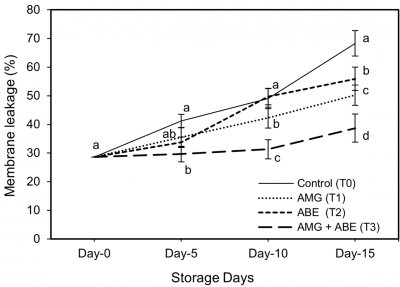
Copyright: © 2024 by the authors. This article is an open access article distributed under the terms and conditions of the Creative Commons Attribution 4.0 International License. J. Hortic. Sci. Technol. © 2024 Pakistan Society for Horticultural Science.
ABSTRACT
Guava fruits have a short postharvest life owing to their climacteric nature and high perishability. Therefore, this research was carried out to evaluate the impact of almond gum (10%) alone or combined with Albizia lebbeck leaf extract (10%) on the storage life of harvested guava fruits. The treatments included control (no coating), almond gum, Albizia leaf extract and almond gum combined with Albizia leaf extract, and three replications. Fresh guava fruits from the orchard were used for the experiment. The treated fruits were stored at 18±2°C and 85% RH. Results revealed that adding Albizia leaf extract to an almond gum-based edible coating significantly enhanced the storage life of guava (>5 days) by maintaining its postharvest quality during storage. Non-coated fruits had 200% more weight loss, and 25% less firmness as compared to the fruits coated with the combination of almond gum and Albizia lebbeck leaf extract. These findings highlight the potential of natural coatings as an eco-friendly solution for the postharvest storage of guava fruits.
INTRODUCTION
The global demand for fresh horticultural commodities has increased significantly recently, creating an urgent need for effective strategies to prolong the marketable life of perishable fruits, including guava (Majeed et al., 2024). Guava (Psidium guajava) is a tropical fruit highly valued for its nutritional content, including vitamins, antioxidants, and dietary fibre. However, guava is highly susceptible to microbial contamination, enzymatic browning, and rapid moisture loss, leading to a short postharvest life and significant post-harvest losses. As a result, developing sustainable, eco-friendly, and efficient preservation methods is critical to improving fruit quality and minimising food waste (Chen et al., 2024).
Edible coatings have emerged as an innovative and natural approach to prolonging the storage life of fresh produce. These coatings, typically made from biopolymers or natural extracts, form a protective barrier around the fruit’s surface, which can reduce moisture loss, slow respiration rate, and inhibit the growth of microorganisms (Priya et al., 2023). By offering these benefits, edible coatings preserve the physical and sensory attributes of fruits and provide an alternative to synthetic preservatives, which may harm consumers and the environment (Perez-Vazquez et al., 2023).
Among the numerous materials studied for edible coatings, almond gum has gained attention due to its unique properties. Almond gum, a polysaccharide derived from the gum of the almond tree (Prunus amygdalus), has been shown to possess excellent film-forming abilities, providing a natural protective layer with minimal impact on taste and texture (Rezaei, et al., 2016). It also contributes to moisture retention and prevents excessive water loss, which is essential in maintaining the freshness of fruits (Amiri et al., 2021). Albizia leaf extract, on the other hand, is known for its antimicrobial, antioxidant, and anti-inflammatory properties. These bioactive compounds help inhibit microbial growth and oxidative reactions, both of which are major contributors to the deterioration of fruit quality during storage (Islam et al., 2020). To date, no study has been found that has used Albizia leaf extract as a treatment to extend the postharvest life of fruits or vegetables alone or in combination with an edible coating. Therefore, combining almond gum with Albizia leaf extract could offer a synergistic effect, enhancing the overall performance of the edible coating while providing multiple functional benefits.
The main objective of this study is to investigate the effect of an edible coating made from almond gum and Albizia leaf extract on the storage-life extension of guava. The research assessed key parameters such as moisture retention, texture, colour, vitamin C and overall sensory quality throughout the storage period. This study aimed to explore the potential of combining natural biopolymers and plant extracts for developing eco-friendly, effective, and sustainable post-harvest preservation techniques. This study aims to provide a sustainable approach to guava preservation, potentially reducing postharvest losses, improving fruit quality, and supporting commercial applications.
Collection of fruit material
Guava fruits were collected from the local orchard. The graded fruits used in the experiment had total soluble solids (TSS) between 7% and 9% and were uniformly mature (green stage) with similar firmness, weight, and shape. The fruits were sorted for any visible sign of damage, disease, or decay.
Preparation of Albizia leaf extract and almond gum coating
Fresh leaves from mature Albizia trees were harvested, thoroughly rinsed with deionised water, and then air-dried for approximately 2 hours, followed by grinding into a fine powder using a kitchen blender for the extraction protocol described by Samant et al. (2023). Almond gum was procured from the market. Initially, the fine powder of almond gum was ground and dissolved in distilled water on a stirrer for 120 min at 70°C to obtain a consistent solution. After adding glycerol, the solution was stirred at room temperature before applying the coating solution.
MATERIALS AND METHODS
The guava fruits were rinsed and then disinfected in a 0.01% NaClO solution for 2 min. This was also followed by removing NaClO residues with deionised water. Glassware and all other laboratory experimental equipment were also sanitised with 1% NaClO solution. The experimental treatments were control (non-coated, T0), 10% almond gum (T1), 10% Albizia leaf extract (T2), and 10% Albizia leaf extract + 10% almond gum (layer by layer, T3). Fresh guava fruits in the light-green stage were selected, and 8˗10 random fruits were chosen for initial analysis on day 0. Ninety-six fruits were distributed among four sets, each subjected to different treatments. One set (control) was treated with deionised water, while the rest of the groups were dipped in their respective solutions for 3 min at 20 ± 2°C. After excess drainage, the fruits were air-dried for 2 hours at 15°C before storage in a cold room (18 ±2°C; 85% RH). Quality attributes were analysed 5, 10, and 15 days after treatments.
Physiological weight loss
Physiological weight loss (%) was calculated by comparing the initial weight of the fruit (on the first day of storage) with its weight on the respective sampling day (Aftab et al., 2023). The physiological weight loss was calculated as follows.
Weight loss =((initial weight – final weight)/initial weight)x100
Browning index and fruit skin colour
The browning index was measured visually on a 12-point scale (0 for no browning to 12 for extreme skin browning), while fruit skin colour was measured on a 9-point scale (9 for green colour to 0 for yellow colour).
Fruit hand firmness
The firmness of the fruits was assessed using the following scale: 9 = hard, 7 = slightly soft, 5 = moderately soft, 3 = soft, and 1 =very soft.
Total soluble solids
Using a digital refractometer, TSS content was measured on each sampling day. Guava fruits were divided lengthwise into three equal parts, and a 10 g sample from each part was homogenised using a pestle and mortar. The TSS of the pulped samples was determined, and the results were reported as the mean of three replications (Mandal et al., 2021).
Titratable acidity
Ten grams of guava juice was homogenised with distilled water, filtered, and diluted to 100 mL. Further, a 10 mL aliquot was mixed with 2-3 drops of phenolphthalein and titrated with 0.1N NaOH until a permanent pink colour appeared. The NaOH volume was noted and used as follows.
Titratable acidity (%) = (Titre volume × NaOH normality × volume of the solution × equivalent weight of predominant organic acid) (volume of extract × weight of sample × 1000)
Vitamin C content
The ascorbic acid contents of guava fruit were assessed using the protocol described by Azam et al. (2021).
Starch content
Starch conversion to sugar was evaluated using the starch-iodine test, as described by Alali et al. (2018).
Membrane leakage
Membrane integrity was assessed using ten fruit tissue discs as described by Saleem et al. (2020).
Statistical design and analysis
The experiment followed a completely randomised design with two factors replicated thrice. The data was analysed according to the analysis of variance at p = 0.05. The means were compared using the LSD test (α= 0.05).
RESULTS
Physiological weight loss
The effect of different edible coatings on the weight loss of guava fruits was found to be statistically significant (Fig. 1). The weight loss of guava fruits at their initial stage showed that non-coated fruits were losing moisture at a greater rate than treated fruits. With the increase in storage days, guava fruits’ weight significantly decreased in each treatment. However, in the control treatment, significant changes and weight loss were observed in guava fruits. However, with the application of almond gum and Albizia leaf extract, the weight loss of guava fruits decreased remarkably. Concerning the effects of coating, T3 had the minimum weight loss (6.02%), which was significantly lower as compared to weight loss in other coatings, i.e. T2 (7.61%) and T1 (7.17%). The maximum weight loss was recorded in T0 (12.22%).
Figure 1: Effect of almond gum combined with Albizia leaf extract on weight loss of stored guava fruits.
Browning index
From day to day, there was a gradual change in the browning index of the guava fruits. The effect of different edible coatings on the browning index of guava fruits was found to be statistically significant (Fig. 2). T0 had the most browning index (9.66) from day 0 to day 15th, and T3 showed the least browning index. T3 (7.66) showed less browning index than T1 (8.0), followed by T2 (8.33).
Figure 2: Effect of almond gum combined with Albizia leaf extract on browning index of stored guava fruits.
Fruit skin colour
The initial colour of guava was green when the fruits were unripe on day 0. The effect of different edible coatings on guava fruit colour was statistically significant. With the passage of days, the colour of guava fruit significantly decreased in each treatment. In control, after 5 days, there were significant changes and loss of green colour due to which the colour of guava fruit turned to light green. However, in the case of applied concentration of almond gum and Albizia leaf extract, the period of colour retention of fruit increased. The different treatment means are given in Figure 3. Concerning the effects of coating, T3 showed the maximum colour retention (7.66), which is significantly higher than the colour in other treatments, whereas T0 (5.66) showed the least colour retention. T2 (7.0) had more colour retention than the control but less than T1 (7.33).
Figure 3: Effect of almond gum combined with Albizia leaf extract on browning index of stored guava fruits.
Total soluble solids
There was a gradual change in the total soluble solids of stored guava fruits. The effect of different edible coatings on the TSS of the guava fruits was found to be statistically significant (Fig. 4). T0 had the most change in TSS content from day 0 (8.22 °Brix) to 15 (9.60 °Brix), and T3 showed the least TSS content. At the end of the experiment, T3 (9.19 °Brix) showed less browning index than T2 (9.27 °Brix), followed by T1 (9.38 °Brix).
Figure 4: Effect of almond gum combined with Albizia leaf extract on total soluble solids of stored guava fruits.
Fruit hand firmness
The texture of guava fruits at their initial stage, i.e. on day 0, was firm and hard. The effect of different edible coatings on guava fruit firmness was found to be statistically significant (Fig. 5). With the passage of days, guava fruit firmness significantly decreased in each treatment. However, in the control treatment, significant change and loss of firmness of guava fruits were observed. However, with the application of almond gum and Albizia leaf extract, the firmness of guava fruits increased. Concerning the effects of coating, T3 had the maximum firmness (7.66), which was significantly higher than firmness in other treatments, i.e., T2 (7.0) and T1 (7.34). The minimum firmness was recorded in T1 (5.75).
Figure 5: Effect of almond gum combined with Albizia leaf extract on fruit hand firmness of stored guava fruits.
Titratable acidity
The effect of different edible coatings on the titratable acidity of guava fruit was statistically significant (Fig. 6). The TA of guava fruits decreased day by day during storage. However, the decrease in TA content was sharp in the control treatment, whereas the influence of almond gum and Albizia leaf extract led to a significant retention of TA loss. T3 showed the least change in TA content, i.e. 0.820 on day 0 to 0.586 on day 15; therefore, T3 had the maximum TA at the end of the experiment (Table 3.4). However, T1 (0.497) and T2 (0.486) showed statistically similar TA content, which was higher than that of T1 (0.321).
Figure 6: Effect of almond gum combined with Albizia leaf extract on titratable acidity of stored guava fruits.
Vitamin C
The effect of different edible coatings on the vitamin C content of guava fruits was found to be statistically significant. Irrespective of treatment, vitamin C decreased in all fruits over time during storage (Fig. 7). However, the decrease in vitamin C was higher in non-coated guava fruits, particularly after day 5. Therefore, the lowest vitamin C value was observed in the non-coated control. Concerning the effects of coating, T3 had the maximum vitamin C (115.49 mg 100 g-1), which was significantly higher as compared to vitamin C in T2 (73.69 mg 100 g-1), T1 (98.09 mg 100 g-1) and control T0 (54.92 mg 100 g-1). So, non-coated fruits had the maximum decline in vitamin C content.
Figure 7: Effect of almond gum combined with Albizia leaf extract on vitamin C of stored guava fruits.
Starch content
The impact of different edible coatings on the starch content of stored guava fruit was statistically significant. Irrespective of treatment, starch content decreased in all fruits over time during storage (Fig. 8). However, the decrease in starch content was higher in non-coated guava fruits, particularly after day 5. Therefore, the lowest starch content was observed in the non-coated control. Concerning the effects of coating, T3 had the maximum starch (3.83), which was significantly higher as compared to vitamin C in T2 (1.80), T1 (2.50), and control T0 (1.07). Consequently, non-coated fruits had the maximum decline in starch content.
Figure 8: Effect of almond gum combined with Albizia leaf extract on starch content of stored guava fruits.
Membrane leakage
The effect of different edible coatings on membrane leakage was found to be statistically significant. With the passage of days, membrane leakage significantly increased in each treatment (Fig. 9). In control, after 5 days, there was a significant change in membrane leakage compared to the rest of the treatments. However, in the case of applied concentration of almond gum and Albizia leaf extract, the membrane leakage of fruit tissues decreased. Concerning the effects of coating, T3 showed the minimum membrane leakage (38.69%), which was significantly lower than other treatments, whereas T0 (68.29%) showed the maximum membrane leakage. T2 (55.9%) had less leakage than the control but more than T1 (50.2%).
Figure 9: Effect of almond gum combined with Albizia leaf extract on membrane leakage of stored guava fruits.
DISCUSSION
Edible coatings based on biopolymers or natural extracts generally form a protective barrier around the surface of fruit (Salehi, 2020). This reduces moisture loss, hence maintaining the fresh weight of the produce. Similar findings were observed in this study, whereby gum-coated fruits had less weight loss. Further, coating the commodities also slows down the respiration rate and inhibits the growth of microorganisms (Priya et al., 2023). As a result, applying an edible coating preserves the physical and sensory attributes of the coated fruits. It provides an alternative to synthetic preservatives, which otherwise are hazardous to humans and the environment alike (Perez-Vazquez et al., 2023).
Coating the harvested guava fruits with almond gum reduced the rate of ripening, as indicated by the decrease in colour, firmness, and biochemical compounds. Almond gum is a hydrocolloid gum obtained from almond trees. Almond gum has been shown to possess excellent film-forming abilities, providing a natural protective layer with minimal impact on taste and texture (Rasool et al., 2023). The film-forming ability of almond gum prevents the easy exchange of O2 and CO2 between the fruit and the ambient atmosphere. This reduces respiration rate and cellular metabolic activities, hence delaying the ripening process of guava fruits. The almond-based coating has been shown to retain moisture and prevent excessive water loss, essential in maintaining the freshness and marketability of fruits (Amiri et al., 2021; Naz et al., 2023). Similarly, guava fruits coated with Albizia leaf extract showed a positive indication of increasing guava storage life. Albizia leaf extract has antimicrobial, antioxidant, and anti-inflammatory properties owing to containing alkaloids, terpenes, phenols, saponins, flavonoids and phytosterols (Balkrishna et al., 2022; Maryam et al., 2023). These bioactive compounds help inhibit microbial growth and oxidative reactions, both of which are major contributors to the deterioration of fruit quality during storage (Islam et al., 2020). In this study, adding Albizia leaf extract to an almond-based coating decreased membrane leakage and increased the accumulation of antioxidants (vitamin C), increasing the cellular integrity of this treatment. Therefore, combining almond gum with Albizia leaf extract showed a synergetic effect that led to the maximum postharvest quality of guava fruits.
CONCLUSION
This study evaluated the impact of almond gum combined with Albizia lebbeck leaf extract on the storage life of guava. Among the treatments, the combined application of almond gum and Albizia leaf extract was the most effective in enhancing the fruit’s postharvest life, as compared to the application of almond gum or leaf extract alone. Therefore, future research should focus on optimising coating concentration, application methods, and cost-effectiveness for commercial-scale implementation.
Declaration of competing interests
The authors declare no conflict of interest.
Author contribution statement
Shaghef Ejaz: Critically reviewed the literature and prepared the manuscript draft. Amna Ramzan: executing the experiment and laboratory analysis. Muttalip Gundogdu: Performed editing and reviewing of the manuscript.
Acknowledgements
The authors thank the Department of Horticulture, Bahauddin Zakariya University, Multan, for providing facilities to conduct this study.
REFERENCES
Aftab, A., Ali, M., Yousaf, Z., Binjawhar, D. N., Hyder, S., Aftab, Z., Maqbool, Z., Shahzadi, Z., Eldin, S. M., Iqbal, R. and Ali, I. 2023. Shelf‐life extension of Fragaria × ananassa Duch. using selenium nanoparticles synthesized from Cassia fistula Linn. leaves. Food Science and Nutrition, 11(6): 3464–3484. [Abstract/FREE full text, PubMed, Google Scholar, CrossRef]
Alali, A.A., Awad, M.A., Al-Qurashi, A.D. and Mohamed, S.A. 2018. Postharvest gum Arabic and salicylic acid dipping affect quality and biochemical changes of ‘Grand Nain’ bananas during shelf life. Scientia Horticulturae, 237: 51–58. [Abstract/FREE full text, Google Scholar, CrossRef]
Amiri, M.S., Mohammadzadeh, V., Yazdi, M.E.T., Barani, M., Rahdar, A. and Kyzas, G.Z. 2021. Plant-Based Gums and Mucilages Applications in Pharmacology and Nanomedicine: A Review. Molecules, 26(6): 1770. [Abstract/FREE full text, PubMed, Google Scholar, CrossRef]
Azam, M., Hameed, L., Qadri, R., Ejaz, S., Aslam, A., Khan, M.I., Shen, J., Zhang, J., Nafees, M., Ahmad, I., Ghani, M.A., Chen, J. and Anjum, N. 2021. Postharvest ascorbic acid application maintained physiological and antioxidant responses of Guava (Psidium guajava L.) at ambient storage. Food Science and Technology, 41(3): 748–754. [Abstract/FREE full text, Google Scholar, CrossRef]
Balkrishna, A., Sakshi, Chauhan, M., Dabas, A. and Arya, V. 2022. A comprehensive insight into the phytochemical, pharmacological potential, and traditional medicinal uses of Albizia lebbeck (L.) Benth. Evidence‐Based Complementary and Alternative Medicine, 2022(1): 5359669. [Abstract/FREE full text, PubMed, Google Scholar, CrossRef]
Chen, N., Wei, W., Yang, Y., Chen, L., Shan, W., Chen, J., Lu, W., Kuang, J. and Wu, C. 2024. Postharvest physiology and handling of guava fruit. Foods, 13(5): 805. [Abstract/FREE full text, PubMed, Google Scholar, CrossRef]
Islam, M. N., Tasnim, H., Arshad, L., Haque, Md. A., Tareq, S.M., Kamal, A. T. M. M., Rahman, Md. M., Reza, A. S. M. A., Chowdhury, K. A. A. and Tareq, A.M. 2020. Stem extract of Albizia richardiana exhibits potent antioxidant, cytotoxic, antimicrobial, anti-inflammatory and thrombolytic effects through in vitro approach. Clinical Phytoscience, 6: 60. [Abstract/FREE full text, Google Scholar, CrossRef]
Majeed, H., Iftikhar, T. and Zohaib, M. 2024. Extension of guava shelf life through the application of edible coating formulated with mango and lemon leaves extracts. Industrial Crops and Products, 216: 118671. [Abstract/FREE full text, Google Scholar, CrossRef]
Mandal, P., Pattanaik, S.K., Nanda, S. and Nath, A. 2021. Studies on processing and storage stability of jamun RTS. International Journal of Agricultural Sciences, 17(AAEBSSD): 182–184. [Abstract/FREE full text, Google Scholar, CrossRef]
Maryam, Jaskani, M.J., Ahmad, I., Nafees, M., Alafari, H.A., Fiaz, S., Fatima, S., Iqbal, R., Alsyaha, D.S., Attia, K., Jalal, A.S. and Uzair, M. 2023. Hybridization and Metaxenial Effects on Biochemical Attributes and Hybrid Development in Date Palm (Phoenix dactylifera L.) Hillawi. Cultivar. Turkish Journal of Agriculture and Forestry, 47(4): 553–566. [Abstract/FREE full text, Google Scholar, CrossRef]
Naz, S., Muhammad, H.M.D., Ali, S., Altaf, M.A., Ahmad, I., Fayssal, S.A. and Ahmad, R. 2023. Reprogramming of salt stress under the influence of melatonin.In: Kumar, R., Altaf, M.A., Lal, M.K., Tiwari, R.K. (eds.) Melatonin in Plants: A Pleiotropic Molecule for Abiotic Stresses and Pathogen Infection. Springer, pp. 45–58. [Abstract/FREE full text, Google Scholar, CrossRef]
Perez-Vazquez, A., Barciela, P., Carpena, M. and Prieto, M. 2023. Edible coatings as a natural packaging system to improve fruit and vegetable shelf life and quality. Foods, 12(19): 3570. [Abstract/FREE full text, PubMed, Google Scholar, CrossRef]
Priya, K., Thirunavookarasu, N. and Chidanand, D.V. 2023. Recent advances in edible coating of food products and its legislations: A review. Journal of Agriculture and Food Research, 12: 100623. [Abstract/FREE full text, PubMed, Google Scholar, CrossRef]
Rasool, F., Zahoor, I., Ayoub, W.S., Ganaie, T.A., Dar, A.H., Farooq, S. and Mir, T.A. 2023. Formulation and characterization of natural almond gum as an edible coating source for enhancing the shelf life of fresh cut pineapple slices. Food Chemistry Advances, 3: 100366. [Abstract/FREE full text, Google Scholar, CrossRef]
Rezaei, A., Nasirpour, A. and Tavanai, H. 2016. Fractionation and some physicochemical properties of almond gum (Amygdalus communis L.) exudates. Food Hydrocolloids, 60: 461–469. [Abstract/FREE full text, Google Scholar, CrossRef]
Saleem, M.S., Ejaz, S., Anjum, M.A., Nawaz, A., Naz, S., Hussain, S., Ali, S. and Canan, İ. 2020. Postharvest application of gum arabic edible coating delays ripening and maintains quality of persimmon fruits during storage. Journal of Food Processing and Preservation, 44(8): e14583. [Abstract/FREE full text, Google Scholar, CrossRef]
Salehi, F. 2020. Edible coating of fruits and vegetables using natural gums: A Review. International Journal of Fruit Science, 20(sup2): S570–S589. [Abstract/FREE full text, Google Scholar, CrossRef]
Samant, S.S., Jagtap, V. A., Kalangutkar, P., Morye, R., Gadekar, A., Rane, R. and Desai, S. 2023. Phytochemistry and therapeutic uses of Albizia lebbeck. International Journal of Herbal Medicine, 11(5): 22–26. [Abstract/FREE full text, Google Scholar, CrossRef]
Guava, almond gum, Albizia lebbeck leaf extract, edible coatings, postharvest life.
* Corresponding author
a Department of Horticulture, Bahauddin Zakariya University, Multan, Pakistan
b Department of Horticulture, Abant Izzet Baysal University, Bolu, Türkiye
Email: shaghef.ejaz@bzu.edu.pk (S. Ejaz)
This article does not contain any abbreviations to display here.
Received: 15 October 2023
Revised: 19 January 2024
Accepted: 10 February 2024
Published: 31 March 2024
How to Cite
| AMA |
Ejaz S, Ramzan A, Gündoğdu M. Enhancing the storage life of guava fruits using layer-by-layer coating of almond gum and Albizia leaf extract. J Hortic Sci Technol. 2024;7(1):32-37. doi:https://doi.org/10.46653/jhst24071032
|
| MLA |
Ejaz, Shaghef, et al. “Enhancing the Storage Life of Guava Fruits Using Layer-by-Layer Coating of Almond Gum and Albizia Leaf Extract.” Journal of Horticultural Science & Technology, vol. 7, no. 1, Mar. 2024, pp. 32–37, https://doi.org/10.46653/jhst24071032.
|
| APA |
Ejaz, S., Ramzan, A., & Gündoğdu, M. (2024). Enhancing the storage life of guava fruits using layer-by-layer coating of almond gum and Albizia leaf extract. Journal of Horticultural Science & Technology, 7(1), 32–37. https://doi.org/10.46653/jhst24071032
|
Download Citation (RIGHT CLICK & “SAVE LINK AS”)
This article do not contain any supplementary data.

